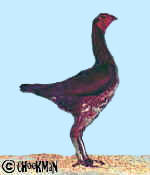The Australian Game originated as a
fighting fowl.
Its ancestry includes Old English Game, Malay Game
and the Aseel. They were in great demand as they possessed great courage and stamina in
the pit, yet were gentle and quite tame towards their owners. Of course those fowls were
much different to the ones we see today.
Because of the use of Malay Game in the breeding,
many birds were bred which were too leggy for fighting. At this time, the craze in the
British chicken fraternity was for long legged birds, such as the Modern Game and Modern
Langshan. With the infusion of Modern Game and Malay blood the long legged
"Colonial" Game soon became popular as a show bird and the development of what
we now call the Australian Game began.
The greatest stalwart of the Australian Game was Mark
Marshall, who wrote in his book, 'The King of Fowls' in 1941, "His close plumage;
fitting his body like wax, his hardness of feather and upright carriage, and his great
size and stately bearing make him a fowl to be wondered at." I recommend this
book to anyone wishing to learn more about the Australian gamefowl breeds.
The body of the Australian Game should be cone
shaped, with no hint of flatness in the wings or wedginess in the breast. Unlike the Malay
Game, they should have a flat back. The feathering is exceptionally hard and close
fitting, with a minimum of down. They should be a balanced fowl, with nice proportions and
massive size.
Bantams have also been developed in a range of colours. |

The perfect pair

A bantam cockerel

A large pullet
|